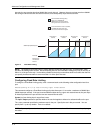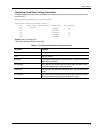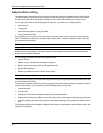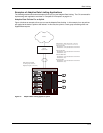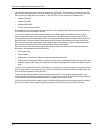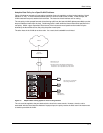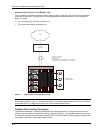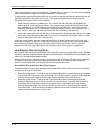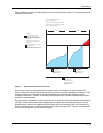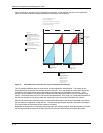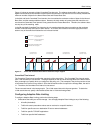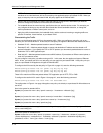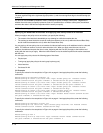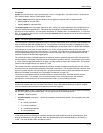
Advanced Configuration and Management Guide
Thus, the Committed Time Interval is 1000000 bits / 10000000 bits = 0.1 seconds. This means that the Adaptive
Rate Limiting parameters apply to time slices of bandwidth 0.1 seconds long.
To determine the maximum Excess Burst Size you can specify, use the Average Rate and Normal Burst Size you
specified to calculate the Committed Time Interval. Then divide the interface’s maximum line rate by the
Committed Time Interval. Here are some examples:
• Assume that the interface is a 100Mbps port. The maximum line rate is therefore 100,000,000 bits per
second, which is 12,500,000 bytes per second. Also assume that you specify an Average Rate of 40,000
bytes (320,000 bits / 8 = 40,000 bytes) and a Normal Burst Size of 4000 bytes. These values result in a
Committed Time Interval of 0.1 (1/10th second). Multiply the interface’s full line rate (12,500,000) by 0.1 to
get 1,250,000. In this case, the maximum Excess Burst Size is 1250000 (1,250,000 bytes).
• Assume the same interface line rate, but specify an Average Rate of 80,000 bytes (640,000 bits / 8 = 80,000
bytes) and a Normal Burst Size of 8000 bytes. In this case, the Committed Time Interval is still 0.1 and the
maximum Excess Burst Size is still 1,250,000 bytes.
Notice that in both of these examples, the Normal Burst Size is 1/10th the Average Rate, which in each case
means the Committed Time Interval is 1/10th second. Because the interface’s full line rate and the Committed
Time Interval are the same in each case, the maximum Excess Burst Size is also the same in each case.
However, the ratio of the Normal Burst Size to the Excess Burst Size in the examples is quite different.
How Adaptive Rate Limiting Works
HP’s Adaptive Rate Limiting polices bandwidth usage on specific interfaces for specific Ethernet traffic, and takes
the actions you specify based on whether the traffic is within the amount of bandwidth you have allocated for the
traffic or has exceeded the bandwidth allocation.
Adaptive Rate Limiting provides this service by counting the number of Ethernet traffic bytes sent or received on
an interface, then taking a specific action depending on whether the count is within the normal bandwidth
allocation (Normal Burst Size) or has exceeded the allocation (Excess Burst Size).
Normal Burst Size and Excess Burst Size Counters
The Adaptive Rate Limiting counts bytes within each Committed Time Interval, which is a slice of time (and thus a
portion of the line rate) on the interface.
• Normal Burst Size counter – The byte counter for the Normal Burst Size increments during each Committed
Time Interval, and is reset to zero at the next interval. Thus, the policy takes the action for conforming traffic
for all the Ethernet traffic’s bytes up to the number of bytes specified by the Normal Burst Size.
• Excess Burst Size counter – The byte counter for the Excess Burst Size increments during each two
Committed Time Intervals, and is reset to zero after every second interval. The policy takes the action for
exceeding traffic for all the Ethernet traffic’s bytes past the maximum Normal Burst Size and up to the
maximum Excess Burst Size. The device drops traffic once the number of bytes exceeds the maximum
Excess Burst Size. The device continues dropping the packets until the next Committed Time Interval, at
which time the Normal Burst Size is reset to zero.
4 - 10



